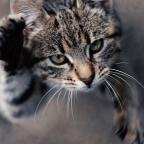
Six bizarre things your cat does, explained by the experts
Cats make wonderful companions, but any cat owner knows they can be curious animals. They like to knock objects off the coffee table, sleep in tight spaces, chatter their teeth and engage in all sorts of weird behaviours.
This weird behaviour isn't just a quirk of your feline friend - the unpredictability can be behavioural or evolutionary. And while you generally discourage traits you see as silly and entertaining, cats might be telling us hoomins what they want and what they hate, too.
Some feline habits are adorable and endearing, while others are totally confusing and even dangerous. If you've ever wondered about the unique, strange cat behaviours, we've spoken to Eleonore Hacheme, Cat Nutritionist at Republic of Cats to better understand the weird things your cat does and why exactly they do them.
Six bizarre things your cat does, explained by the experts
-
Kneading
Cat kneading - also called 'making biscuits' - is an endearing trait, usually seen when they are being petted or when snuggling into a napping spot. This behaviour is displayed as the rhythmic pushing of their paws in and out at alternating times. Some cats will retract their claws while they knead - others don't.
Our feline friends will do this on soft surfaces like fluffy throws, or when getting cosy or on your lap when you are making a fuss over them. Your pet may also knead against you to show their love and affection towards you.
Aside from being another way to mark their scent onto surfaces using their paw pads, cats kneading you is a way to show you that they feel comfortable around you. Kneading is often accompanied by pawing, purring and drooling combined.
-
Napping in small spaces
Shoeboxes, bathroom sinks and even empty cardboard boxes are only a few of the weird and wonderful places where your cat might choose for a nap.
Cats like to squeeze into tight spaces where they feel safer and more secure as opposed to being exposed to potential danger in an open space, even if the perceived danger in your home is the washing machine or the vacuum cleaner. They crawl into drawers, baskets and boxes. They climb into hidden corners, under beds and tables. Cats have a natural need for warmth and protection, and these confined spaces give cats a quiet, peaceful environment.
To make your home the perfect haven for your pet, you should ensure they have a variety of cosy places where they can curl up and relax.
-
Headbutting or bunting
Head-butting, also commonly known as bunting or facial marking, is when a cat uses their head to make contact with you, on your knee, face, leg or any other part of the body. They might gently push their head against yours, or they might give you a hard hit to the skull.
You've probably seen your cat headbutting walls, chairs and furniture too. While this behaviour might seem very strange, cats are just leaving their mark on that object. Cats have scent glands all over their bodies, including their face and cheeks. So when they butt heads with something, they are leaving their scent on you or another object. Doing this shows they trust and respect that object by acknowledging its familiarity.
-
Brings you 'presents'
Our feline friends are innate hunters and are instinctively attracted to moving objects such as a mouse or bird. Even if domesticated cats don't need to catch their food to survive, they cannot resist the natural urge to kill and retrieve, bringing their prey back into a safe place.
When your pet brings you their 'hunt', it can be considered a compliment and that the gift is brought to you because they're feeling charitable and they love and care for you. They could also be bringing you dead animals because they want to teach you how to hunt for prey, as a mother cat would do for its kittens.
-
Tail twitching
A cat's tail is an excellent tool for feline self-expression. If its tail is twitching back and forth, it is often associated with hunting behaviour. The moving tail indicates an intense focus on its prey, getting in the position ready to pounce. The twitching can also indicate that your pet is feeling alert and interested in something happening in its surroundings.
If you're petting your cat and you start seeing the tip of its tail twitching, this could be an early sign that your cat is getting overstimulated and wants some space. Or if its tail is swishing strongly from side to side, feelings of anger or irritability could be creeping in, so you should respect their need for space and privacy.
-
Intrigued by electronic devices
Sometimes cats do things that we humans have a hard time understanding. And sleeping next to or on top of our electronic devices is one of them. Cats may sit on or near computers, TVs, phones or tablets because they are warm and have stimulating images on the screen.
A second reason your cats like to sit on your electronics is that they want interaction and attraction and are trying to take the attention away from your electronic device. Cats can be quite territorial and they're marking their spot on your personal items and establishing their ownership by giving it a scent that is uniquely theirs.







